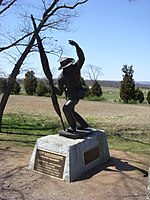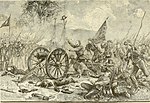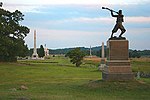Virginia Monument
1917 establishments in Pennsylvania1917 sculpturesBronze sculptures in PennsylvaniaConfederate States of America monuments and memorials in PennsylvaniaEquestrian statues in Pennsylvania ... and 3 more
Gettysburg Battlefield monuments and memorialsStatues of Robert E. LeeVirginia in the American Civil War

The Virginia Monument is a Battle of Gettysburg memorial to the commonwealth's "Sons at Gettysburg" (Battlefield) with a bronze statue of Robert E. Lee on his horse Traveller and a "bronze group of figures representing the Artillery, Infantry, and Cavalry of the Confederate Army".: '17 The equestrian statue is atop a granite pedestal and the group of six standing figures is on a sculptured bronze base with the figures facing the Field of Pickett's Charge and the equestrian statue of Union General George G. Meade on Cemetery Ridge.
Excerpt from the Wikipedia article Virginia Monument (License: CC BY-SA 3.0, Authors, Images).Virginia Monument
West Confederate Avenue,
Geographical coordinates (GPS) Address Nearby Places Show on map
Geographical coordinates (GPS)
| Latitude | Longitude |
|---|---|
| N 39.814133333333 ° | E -77.250316666667 ° |
Address
State of Virginia
West Confederate Avenue
17325
Pennsylvania, United States
Open on Google Maps








